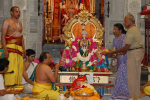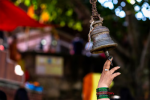Lord Ayyappan Sacred 18 steps
.png)
Several myths persist regarding the significance of the Pathinettu thripadikal or the 18 holy steps, but almost all of them stress the importance of the number, 18. According to a popular belief, the first 5 steps signify the five indriyas or the senses (eyes, ears, nose, tongue and skin), the following 8 the ragas (tatwa, kama, krodha, moha, lobha, madha, matsraya, and ahamkara), the next 3 the gunas (satwa, rajas and thamas) followed by vidya and avidya. Climbing these would take the devotee closer to self-realisation. The act of crossing the 18 steps is so sacred that nobody can mount them without undertaking the rigorous 41 day fast and carrying the irumudi. It is also widely assumed that the pathinettu padikal symbolize the 18 puranas; others believe that they connote the 18 weapons with which Lord Ayyappan obliterated evil.

An Ayyappa devotee crosses the Pathinettaam padi only twice during his sojourn on Sabarimala - for entering the temple and to go downhill. Before ascending or descending the steps, pilgrims break coconut as an offering to the steps. One needs to have the sacred Irumudi on head while going up or down the 18 steps and while descending the steps the devotees climb down backwards facing the sanctum sanctorum.
Steps Explained
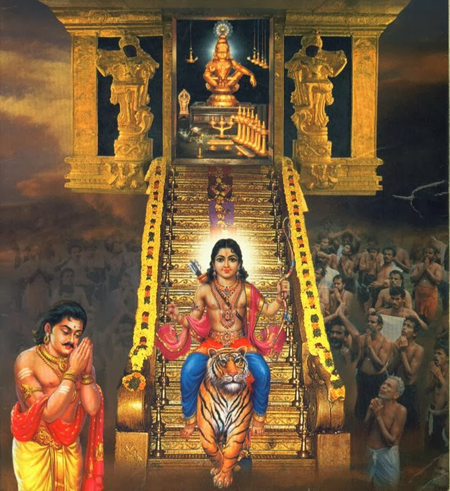
1 Ears (sound) - Listen only to good talks related to God (satsangs) avoid listening to gossiping that strengthen our Ego of finding fault with others and feel us superior.
2 Eyes (sight) - See things that are good and create inner inspiration. Avoid sensual sights that trigger unwanted desires in us, like sexual content or material possessions. But those things that meet our basic needs of life and not that fulfills our wants (greed).
3 Skin (Touch) - Stimulating touch (sex) is to be avoided. Enjoy sense of touch of japa-maala (rosary beads) that helps in chanting God's name. Feel the feather soft of flowers and feel that we should show that soft compassion to others.
4 Nose (smell) - associate smells of flowers and scents related to Lord's pooja. Pay attention to addictive smell of food.
5 Tongue (taste). Eat very satwic food that does not create addiction and over-indulgence like sweets and spicy hot foods. Eat food that are healthyand natural. One can eat natural sweets like dates, raisins and honey
6 Kama (Desire or possession)

7 Krodha (anger when desires do not get fulfilled or when desired possession is lost).
8 Lobha (greed to fulfill the desire or not allowing anyone partake in one's possession),
9 Moha (Infatuation of the obtained result or having the possession).
10 Mada (pride of getting the desire fulfilled or having a possession)
11 Matsarya (Jealousy that others should not get what we have fulfilled our desire or when others have a possession that we have.)
12 Tamas: The Inertia (not to do action) or lazy or sluggish attitude is Tamasic. This is overcome by doing getting up early in morning having cold- water-baths doing pooja or worship. We dont want to do these because we are lazy in doing this. Only by doing these we overcome Tamasic nature.
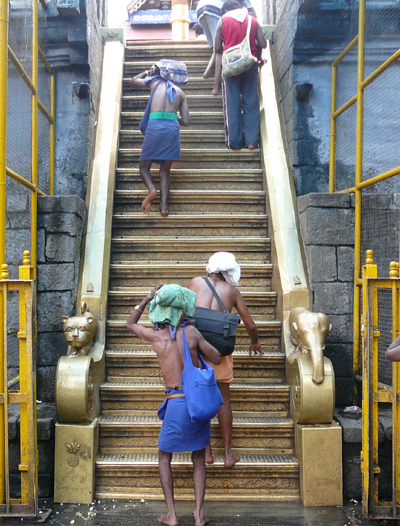
13 Rajas: Action oriented with the feeling of "I". By constant mantra Japa of Saranam Ayyappa, this I doing the action feeling get diminished.
14 Sattva: Goodness. The feeling of I am good is also a Ego feeling. That also should be transcended as Krisha says in Gita. Feel everyone who are doing bad are doing due to ignorance. We should not ignore them, by by compassion help them to grow out of it.
15 Raga: The strong likes or attachments that we use in making decisions. This is possible only by developing Bhakthi to Ayyappa. This means to surrender all likes to Lord for the common good.
16 Dvesha: Same way the strong dislikes also should be given up in making decisions. Also through surrender attitude (Bhakthi) we can transcend this attitude.
17 Avidya: The Knowledge about physical material things alone is Avidya. Vidya is the knowledge of Truth. By attending satsangs of Guru alone will help to gain the highest knowledge.
18 Ahamkara (Identity): All the attachments is summarized as this one factor, the identity felling of "I". This is the final step or block in reaching Ayyappa. Wearing black clothes and addressing ourselves and others as "Swami Ayyappa" dissolves this identity like a salt doll plunging into a salty ocean.
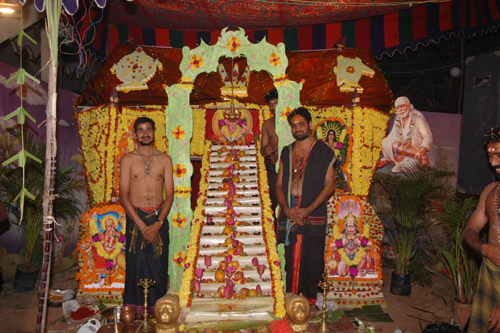
All these exercises are included in the Ayyppa 42 days Vratham. Only doing these practices one makes the Irumudi-kettu and goes to Ayyappa. This is why the 18 steps are allowed to step only those who have the Irumudi-kettu, which means they have practiced the 18 steps to realize the Lord. All the above 18 aspects of Ego shrinks the identity to a mere mortal body subjected to birth and death. But doing the 18 exercises one transcends these 18 blocks and attains Self-realization. Aham Brahmasmi - Tat Tvam Asi






